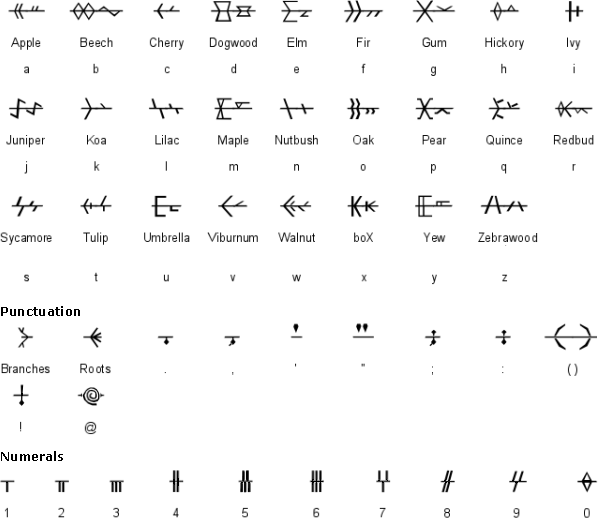Applebeech

Michael McIntyre (dmmcintyr[at]users[dot]sourceforge[dot]net) created
the Applebeech in the spring of 2005 in order to serve as a fully functional
runic writing system for the modern English language. It is intended to be
used for obfuscating messages without making it necessary to alter their
natural spelling. He uses it for inscriptions set in concrete around his
garden, for example.
Many ancient inscriptions found on the British Isles used the
Ogham and the Futhark, and
both of these were used to write in a variety of languages on the Isles in
days of yore. However, neither of these allows a simple one-to-one correspondence
with the more commonly-used Latin alphabet. The Applebeech combines elements
of both of these ancient systems into a complete new alphabet of trees which
is an Ogham-like expression of Futhark-like runes.
Notable features
- Each letter is named after a tree or shrub.
- The trees and shrubs are either indigenous to or widely naturalized in
the mountains of the east coast of the United States, except for Koa, Quince,
Umbrella, boX and Zebrawood. (Ivy is neither a tree nor a shrub, but the
woods are full of “ivy trees” (and “kudzu trees” for that matter)). - Like the Ogham, letters are linked together by a solid line, which represents
the trunk of a tree, while the letters themselves represent branches or twigs,
and many of the punctuation marks represent “berries” (the square dot equivalents
which always hang from the “tree” in some fashion) or “nuts” (the free-floating
shapes found in the quotation marks). - Applebeech can be written either horizontally or vertically.
- Paragraphs begin with the Branches symbol and end with the Roots, so it can
be written top to bottom or top to bottom (but it would be illogical to carve
it bottom to top on the trunk of a tree, with Branches at the bottom). - Applebeech features both upper- and lowercase letters, numbers, and a mostly
complete set of punctuation.
Used to write
The Applebeech is currently only useful for writing modern English. It will
eventually acquire characters for Spanish, French and Esperanto.
The Applebeech alphabet

Construction details
All of the letters are composed entirely of straight lines because this
is a writing system intended to be hacked into things with a set of two
chisels (one twice as wide as the other). Many of the uppercase characters
are straightened out versions of their Futhark counterparts turned on their
side (horizontally, or in their normal orientation vertically), and some
are mirrored. The lowercase forms extend only half as far above and below
the line as their uppercase counterparts, and most of them are abbreviated
to roughly half the number of strokes.
For example, the letter Apple is very similar to its Futhark counterpart
rotated 90 degrees counterclockwise, and then mirrored. The lowercase form
is shorter, and is not mirrored.

Some letters, such as Maple, are not mirrored, but merely turned on their
sides, with the lowercase form abbreviated by randomly chopping off the top
or the bottom.
The punctuation characters are not so easy to hack with straight chisels,
and would require some finer chisel work with a third, much more narrow chisel,
or perhaps some specially-ground punches. This is a failing, but the alphabet’s
creator assumes that anyone using such characters will probably be writing at
a computer, with a font, rather than hacking on a hunk of wood with some sharp bits
of metal. They are mostly included for simple “Applebeechification” of existing
texts, and have not been as well thought-out or as well-executed as the letters
themselves. (The applebeechmedium font includes many glyphs not depicted above
because they look too bad. Punctuation is a work in progress).
Sample text in the Applebeech alphabet

Translation
All human beings are born free and equal in dignity and rights. They
are endowed with reason and conscience and should act towards one another
in a spirit of brotherhood.
(Article 1 of the Universal Declaration of Human Rights)
